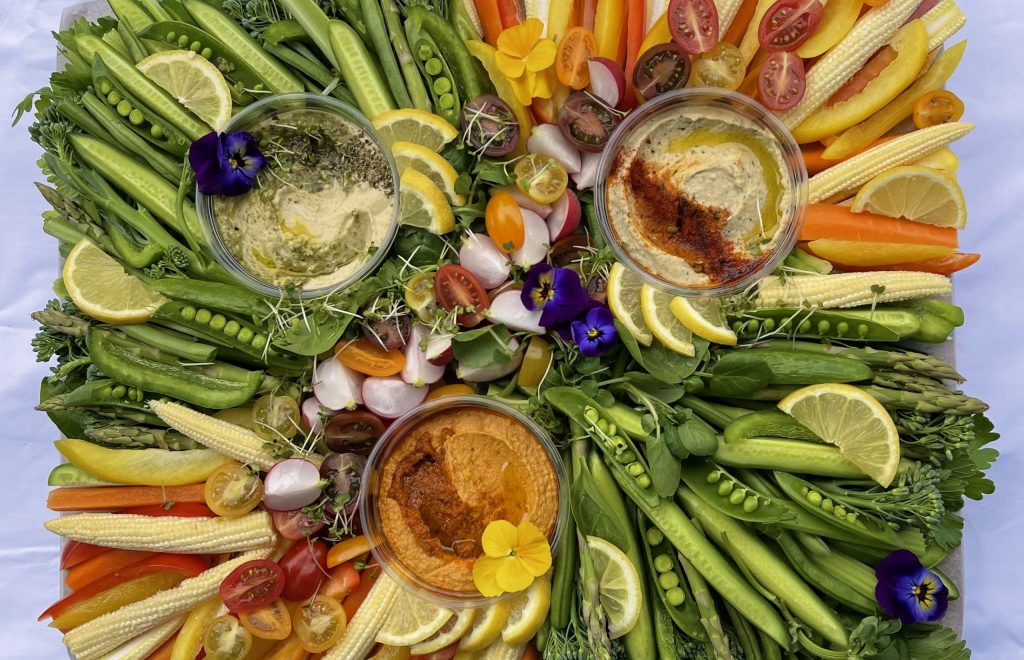Whether you are hosting an event, packing a picnic, or looking to elevate your typical carrot sticks and hummus, a crudités platter is a hugely versatile dish that looks and tastes great. In this article, find out what should be included on a veggie platter, the secret to keeping your vegetables crisp and fresh, plus our favourite dips and spreads!
What is a crudités platter? A crudités platter (pronounced crew-de-teh) is simply another name for a vegetable platter, typically served at parties, picnics, or other social events. The platter consists of a range of fresh vegetables, cut into bite-sized sticks and shapes, and is typically served with sauces and spreads for dipping. These dips might include pesto, hummus, or tzatziki.
Read on to find out what you should include on your colourful and delicious crudités platter, how to keep everything tasty and fresh throughout the day, as well as some other top tips.
What Goes On a Crudités Platter?
We’ve outlined our favourite vegetables to include on a crudités platter, alongside our dip recommendations, and of course, how to make your board look gorgeous with garnishes and decorations!
Vegetables
A good rule of thumb is to include at least 10 types of veggies on your board, preferably with a range of colours, shapes, and textures for your board to look great! You should consider vegetables that are in season for the freshest flavours. Read our Seasonal Eating Guide to find out more.
We’ve outlined some of our favourite vegetable choices below, plus the best way to prep them for your grazing board:
Celery
Start by lightly peeling your celery sticks to get rid of any of the chewy outside layers. Depending on the thickness of each celery stick, you could cut them in half lengthways before chopping them into finger-sized sticks.
Carrots
If you can, opt for carrots that come in a range of colours, from yellow to purple, to orange. Chantonnay, Gold Nugget, or the Dragon variety all look great on a board, and generally only grow to around 5 inches in length, making them ideal finger food.
Baby Sweetcorn
Sweetcorn, the baby variety in particular, offers a sweet and nutty taste that goes excellently with hummus or sour cream dips. The great thing about baby sweetcorn is that they can be left whole on your crudité platter as they are already the perfect size for dunking!
Radishes
Pink radishes add a great pop of colour to your board, not to mention their delicious crunchy and peppery taste! Either quarter each radish, or thinly slice and scatter around the board for decoration. Any young leaves can be left on and are safe to eat raw.
Tomatoes
For easy eating, we’d recommend baby tomatoes, particularly baby plum tomatoes for your platter. Not only do these offer a deliciously sweet flavour but they come in a range of colours, from yellow to red, to purple, making an exciting addition to your board!
Cucumber
Ah, the classic cucumber! These are excellent for cutting into simple sticks, or simply slice in half lengthways if you are using baby cucumbers (also known as snacking cucumbers). If you have a Crinkle Cut Knife (this one from Amazon is just £5.99 and works a charm!) try cutting your large cucumber into funky rounds to layer across the edge of your crudité platter.
Grapes
Grapes add the perfect amount of sweetness to a charcuterie board, and they taste great on a vegetable platter too! We’d recommend cutting your grapes lengthways to expose both the inside and out. If you are creating a larger crudité platter, however, leave your grapes in small bunches and scatter them throughout the board.
Sugar Snap Peas
Sugar snap peas (or snow peas) are delicious eaten raw! Use a small knife to remove the chewy string that runs down the back of each pea before adding to your platter. Serve as they are or slice a few down the middle to expose the small peas found inside.
Peppers
Bell peppers come in a range of colours, making them a tasty and pretty choice for your board. Simply slice the larger types into sticks, or slice Romano peppers into smaller rounds to add to the interesting shapes on your board.
Broccoli
We’d avoid your typical broccoli here and instead opt for the Tenderstem variety, as the smaller shape is easier to eat (and dip!). If your local supermarket stocks the Purple stem broccoli, this would look fantastic as a pop of colour on your board. You can eat broccoli raw, however, we’d blanch each stem in hot water for just a few minutes to soften.
Asparagus
Like broccoli, asparagus can simply be blanched and left whole before adding to your board. Their mild flavour and long shape make asparagus excellent for dipping into spreads and hummus.
Leaves (Arugula, Radicchio, Spinach, etc)
Leaves are ideal for placing around your bowl of chosen dip for decoration, or around the outside of the platter, sort of acting as a border. We also love using microgreens to sprinkle across the board for an extra zing of peppery flavour.
If you’re looking for more delicious recipes for the summertime, check out our Grilled Courgette & Feta Salad or our Butter Bean & Courgette Salad.
Dips & Spreads
The best part about a vegetable platter is the dip (at least in our opinion!). These can be store-bought or made ahead of time, provided you keep them refrigerated.
Hummus
Hummus may sound like the obvious choice but it is our go-to for a crudité platter. Feel free to experiment with a variety of flavours here – we love interesting varieties like beetroot and mint, sweet potato, or roasted red pepper hummus.
Baba Ganoush
Baba Ganoush is made from a combination of slow-roasted aubergine, tahini, olive oil, garlic, salt, and fresh lemon juice. The dip offers a smoky flavour and creamy texture which compliments vegetables and pitta bread well.
Soft Cheese
If you’re short on time, or you’re on a budget, a simple tub of Philadelphia cream cheese is a great option for veggie dunking. The brand offers a variety of flavours including Garlic & Herb, Sweet Chilli, and Jalapeno, as well as dairy-free options if you require them.
Whipped Feta Dip
This feta dip has been all over TikTok recently, and rightly so – its delicious! Simply whip up a block of feta in a food processor and combine with a cup of Greek yoghurt, a few garlic cloves, and olive oil, before seasoning generously with salt and pepper.
Tzatziki
Yoghurt-based dips are tasty and refreshing, ideal for a hot summer’s day. Make a simple tzatziki sauce by combining Greek yoghurt, chopped cucumber, crushed garlic, and a handful of mint in a bowl.
Garnishes
To take your crudité platter to the next level, you must decorate your board accordingly. We’ve outlined a few ideas below:
Fresh Herbs
We love using fresh herbs to decorate all of our grazing boards. In the summertime, sprigs of fresh mint work wonders on a board. Simply leave in small bunches for decoration, or sprinkle over your crudités for fresh flavours. When the colder months draw in, opt for rosemary or thyme for a more festive feel.
Edible Flowers
We love adding edible flowers to our platters, whether cheese, meat, or vegetable spreads. They add a colourful touch to any visual, and work particularly well in the Spring and Summertime. You could use any flowers to decorate, our favourite being Baby’s Breath, but ideally you’d go for the edible variety, such as Dahlias, Cornflowers, or Hibiscus.

How To Arrange Your Crudités Platter
Start by placing your chosen dips in the centre of the board. You could use sustainable bamboo bowls here, or get creative and use a whole bell pepper to hold the sauce. Once your dips are in place, arrange your vegetables around the platter. Start with the bigger vegetable sticks around the outside, creating a base, before filling in the inside and gaps with smaller fruits and vegetables (such as radishes, grapes, olives, etc). Finish your board with carefully arranged fresh flowers, herbs, and microgreens.
A well-arranged crudités platter is a great appetiser for any dinner party. If you’d like to find out more about hosting friends and family, read our recent blog: How to Host a Fuss-Free Dinner Party
How Do You Keep Crudités Fresh & Can You Prepare a Platter In Advance?
You can prepare most elements of a vegetable platter in advance, either the morning of or the night before. Ideally, you’ll want to prepare your vegetables as close as possible to serving time, and we’d recommend no longer than three hours beforehand to ensure your vegetables stay fresh and crisp. Store your hardy vegetables, such as carrots, cucumber, and baby sweetcorn in water and in the fridge if you must prepare them the day before.
As for dips, hummus, and spreads, these can be made the night before. Simply follow your chosen recipe, place in an airtight container (this not only seals in the fresh flavours, but also stops oxidation), and store in the fridge. Allow everything to come to room temperature before serving.
If you’re adding fresh flowers to your platter, either as decoration or those of the edible sort, add them just before serving as they tend to wilt after a few hours.
Locally Sourced Crudité Platters From Savery Grazing
Crudité platters are an ideal light option for guests in the Summertime and are great for balancing out heavier dishes at your event such as charcuterie boards, brunch spreads, or grazing tables.
If you’re based in Sheffield or Derbyshire, why not order a crudités platter for your next event from Savery Grazing? We source all of our produce locally, with each of our platters using only the freshest, highest-quality ingredients.
If you’d like to place an order, or you have a question for our team, don’t hesitate to contact us via phone or email – we’d love to hear from you!
Crudités Platter FAQs
How Do You Cut Vegetables For Crudités?
When cutting up your vegetables, keep in mind two things; firstly, the shape should be small enough to eat in one or two bits, and secondly should allow your guests to dunk in the dip without getting their fingers messy!
For your longer vegetables, like carrots, celery, or asparagus, we’d suggest cutting them into small sticks. Mini bell peppers and cucumbers are great cut into small disks instead of sticks for a variety of shapes on your board. Baby tomatoes, radishes, and grapes can be halved or cut into fun star shapes if you have the time to do so.
Should You Blanch Vegetables For a Crudité Platter?
Some vegetables can be excessively chewy if they’re served raw, however, not all fruits and vegetables will need to be blanched for your platter. We’d recommend blanching the following items:
- Baby sweetcorn
- Broccoli
- Green beans
- Asparagus
To soften these vegetables whilst keeping them crisp to the bite, simply bring a pot of water to boil, and drop in your vegetables, taking them out after one minute or so. Leave to air dry and refrigerate if you aren’t using them straight away.
What Is the Difference Between Crudité and Charcuterie?
Charcuterie (pronounced shar-koo-tar-ee) is the typical name for a selection of meats, whether that be salami, chorizo, or parma ham. A charcuterie board is also sometimes used to describe a meat and cheese board. Crudités or a crudités platter refers to raw vegetables or a platter of sliced or whole vegetables alongside dips and spreads.






